To mix perfect floral accords, you'll need a digital scale with 0.01g accuracy and a basic calculator for precise measurements. Start with a 55-20-25 ratio (base, middle, top notes) and adjust based on your desired fragrance profile. Use spreadsheets to track ingredients and maintain consistency in your formulations. Test combinations on paper strips first, and document successful blends for future reference. The right mathematical approach and proper tools will reveal endless possibilities in floral accord creation.
Understanding the Mathematics Behind Floral Accords
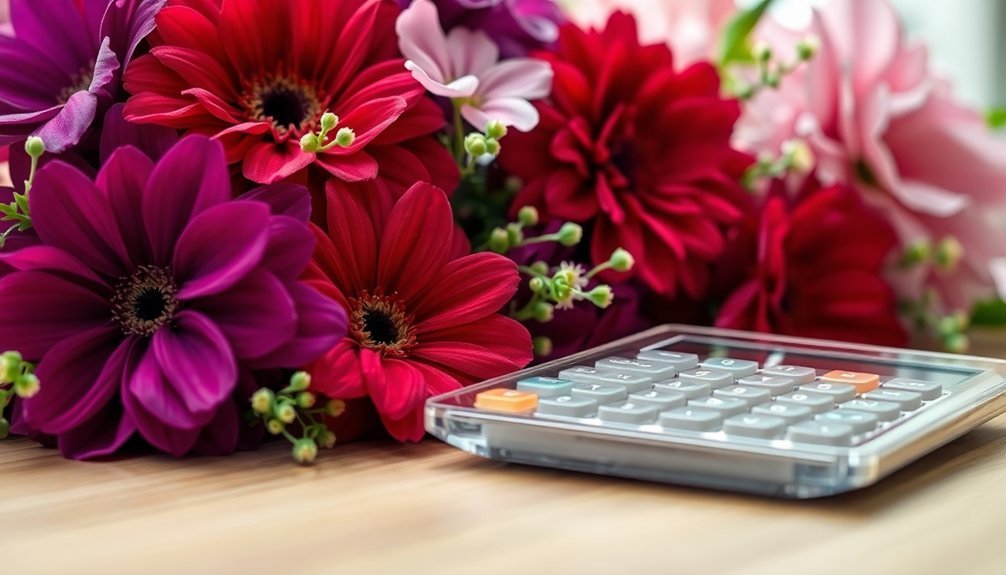
While many people admire flowers for their beauty alone, there's a fascinating mathematical foundation behind their structure and growth patterns. You'll find the Fibonacci sequence dictating the number of petals, from lilies with 3 petals to black-eyed Susans with 21. This sequence isn't random – it's nature's way of maximizing sunlight exposure and pollinator access.
When you look closely at a flower's structure, you'll notice petals arranged at the golden angle of 137.5 degrees, creating perfect spirals. This arrangement, known as phyllotaxis, follows the golden ratio (1.618…), ensuring ideal space efficiency. Fractal geometry patterns can be observed in the complex ruffled edges of flower petals.
Whether you're examining radially symmetric buttercups or bilaterally symmetric lavender, you're witnessing nature's mathematical precision at work. Understanding these patterns helps you appreciate the intricate balance between beauty and functionality in floral design.
Essential Tools for Calculating Floral Ratios
Digital tools like spreadsheets and specialized floral calculators help you determine precise stem counts and proportions, while saving time on complex calculations.
Weight measurement equipment, including digital scales and measuring cups, allows you to portion out exact quantities of flowers and greenery according to your calculated ratios.
Following the Fibonacci sequence will help you create visually balanced and mathematically harmonious arrangements that naturally please the eye.
Digital Mixing Software Tools
Modern digital mixing software has revolutionized how perfumers create and refine floral accords. You'll find these tools essential for achieving precision and consistency in your formulations while minimizing waste through virtual experimentation.
With cloud-based platforms, you can access extensive ingredient databases and use algorithmic predictions to identify harmonious scent combinations. Perfumers can now test unique pairings like saffron and leather for distinctive signature scents. You're able to visualize volatility curves and note longevity, making it easier to perfect your formulas before physical mixing.
These tools let you track real-time costs and suggest cost-effective alternatives while maintaining quality. You can collaborate with other perfumers globally, sharing formulations and accessing collective expertise.
The software's virtual blending studios allow you to make rapid modifications and receive instant feedback on your creations, streamlining your development process from concept to final product.
Basic Weight Measurement Equipment
Precise measurement tools form the foundation of successful floral accord creation. You'll need a digital scale with 0.01g accuracy to weigh your ingredients perfectly. Keep your measurements consistent by using the tare function and maintaining clean equipment.
| Essential Tool | Purpose |
|---|---|
| Digital Scale | Precise ingredient weighing |
| Conversion Calculator | Unit conversions (g to oz) |
| Protective Cover | Equipment protection |
| Storage Case | Safe equipment storage |
| Cleaning Supplies | Maintaining accuracy |
Don't forget to check your scale's battery regularly and keep it calibrated. You'll want to store your equipment in a dust-free environment to guarantee long-term accuracy. When measuring small quantities, use the scale's smallest division setting for the most precise results. Remember to clean your equipment after each use with appropriate cleaning solutions to prevent cross-contamination between different floral materials.
Step-by-Step Guide to Using the Floral Calculator
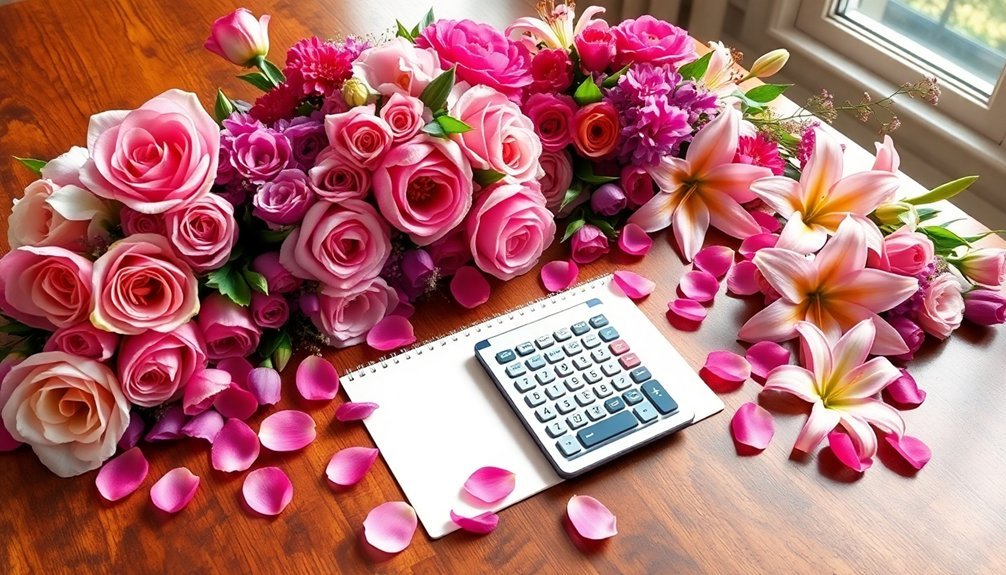
Creating professional floral accords begins with mastering the essential tool known as the floral calculator. You'll find this spreadsheet-based system streamlines your formulation process while ensuring precise measurements for each ingredient.
Start by entering your raw materials into designated cells, including your chosen flowers, essential oils, and other fragrant components.
- Open your calculator and create columns for ingredient names, percentages, and weights
- Enter your core floral components like rose, jasmine, or ylang-ylang
- Input the target percentage for each ingredient based on your desired accord strength
- Let the calculator automatically compute the exact amounts needed
- Save your successful formulations for future reference and modifications
Remember to regularly update your calculations as you experiment with different combinations and adjust ratios to achieve your perfect floral accord.
Balancing Top, Middle, and Base Floral Notes
While mastering floral accords requires technical precision, the art of balancing top, middle, and base notes alters a simple blend into an enchanting fragrance.
You'll need to carefully layer your components, starting with vibrant top notes like orange blossom that create an immediate impact but fade quickly.
Next, incorporate middle notes such as rose or lily of the valley – they'll form your fragrance's heart, lasting several hours and providing the main character of your blend.
For lasting power, you'll want to anchor your creation with rich base notes like tuberose or orchid. These deep florals can persist for days and add warmth to your composition.
Remember to adjust the proportions of each note carefully – you're aiming for a smooth change that mirrors nature's own progression.
Common Floral Combinations and Their Proportions
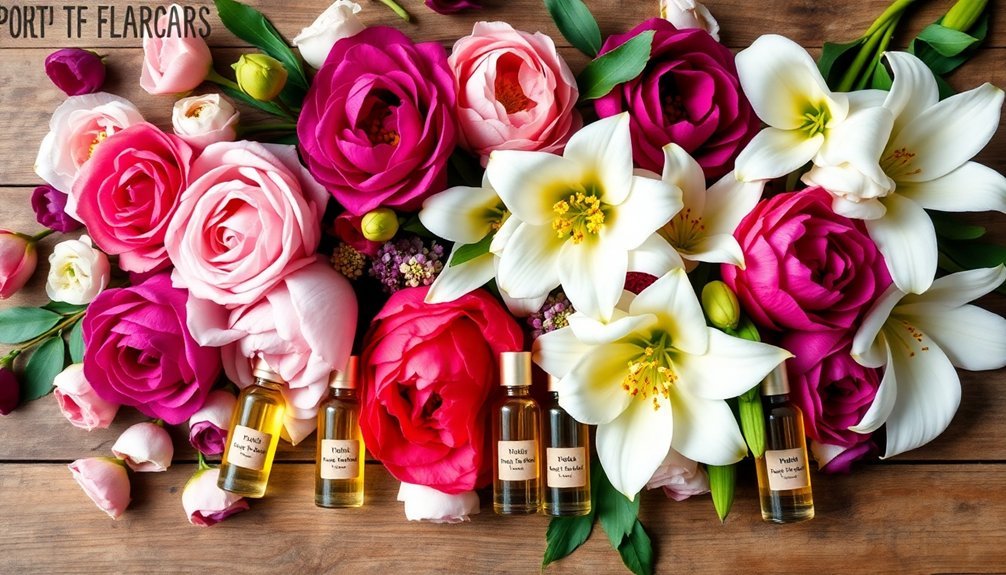
Four essential floral combinations form the foundation of modern perfumery: rose-jasmine, lavender-hyacinth, orchid-vanilla, and gardenia-orange blossom.
You'll find these pairings create balanced, sophisticated fragrances that work seamlessly in different seasons and occasions. Rose-jasmine offers spicy sweetness, while lavender-hyacinth delivers calming spring notes. Orchid-vanilla creates a rich, warm base, and gardenia-orange blossom provides crisp, daytime freshness.
- Rose and jasmine blend well with lavender for a complex, romantic scent
- Hyacinth's sweet notes complement lavender's calming properties
- Orchid's light, airy notes balance vanilla's rich warmth
- Gardenia pairs perfectly with citrus for a clean, natural fragrance
These combinations work effectively with fruity, woody, spicy, or anisic notes.
Troubleshooting Your Floral Accord Calculations
Successful floral accord creation depends on identifying and resolving common issues that can affect your fragrance's balance, strength, and harmony.
If your blend lacks impact, check your top notes – you might need more citrus or green elements. For weak scents, examine your fragrance concentration and wax compatibility.
When troubleshooting specific ingredients, pay attention to the balance between eugenol and dihydroeugenol in spicy floral accords. You'll need to adjust hedione and cyclosia proportions to perfect the fresh floral aspects.
Watch for overpowering middle notes like jasmine or rose that can dominate your blend.
Remember that achieving harmony often requires patient iteration and comparative testing. Use test strips for incremental adjustments, and don't rush the aging and curing process, as these factors greatly influence your final fragrance's strength and stability.
Advanced Techniques for Complex Floral Blends
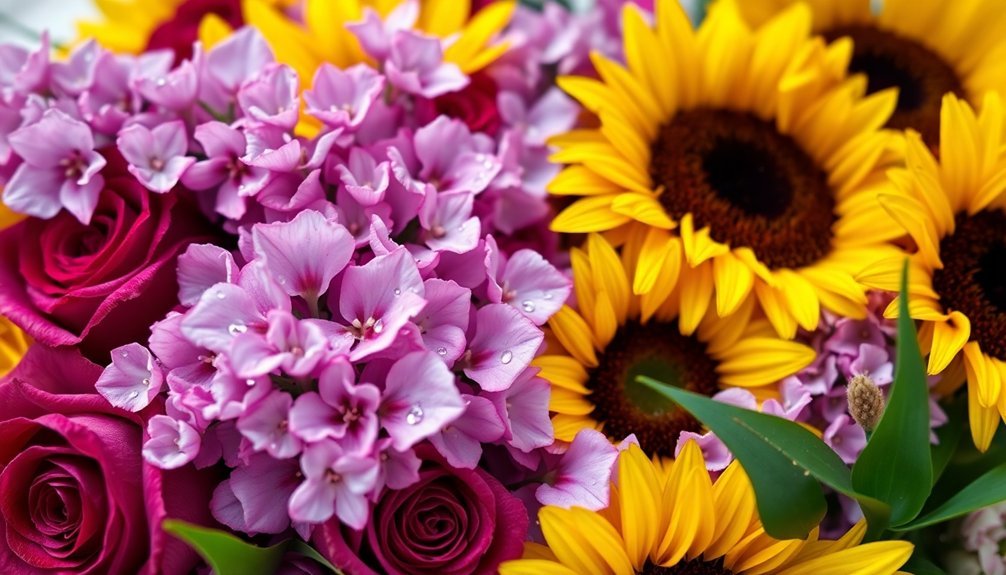
When you're ready to take your floral blends to the next level, you'll need to master the art of layering multiple floral notes while maintaining their distinct characteristics through precise calculations.
You can achieve superior depth by carefully adjusting the intensity ratios between dominant and subtle floral components, typically starting with a 3:1 ratio and fine-tuning from there.
Understanding synergistic essential oil relationships will help you maximize the impact of each ingredient, as certain combinations can amplify desired notes while minimizing unwanted ones.
Layering Multiple Floral Notes
Mastering the art of layering multiple floral notes requires understanding how different scents interact and complement each other over time.
Start by applying lighter fragrances on moisturized pulse points, allowing each layer to settle before adding stronger notes. You'll find that rose pairs beautifully with jasmine, while neroli complements lavender for a fresh, calming effect.
- Apply fragrances to warm, moisturized skin at pulse points like wrists and neck
- Layer lighter floral scents first, followed by richer notes
- Use the fragrance wheel to identify complementary pairings
- Consider seasonal variations – opt for lighter blends in summer, richer ones in winter
- Allow each layer to dry completely before adding the next
Experiment with citrus or woody accords to enhance your floral combinations, and don't forget to check how the scents evolve throughout the day.
Balancing Intensity and Depth
Building upon the foundation of layered florals, the art of balancing intensity and depth takes your fragrance creation to new heights.
You'll need to master the delicate interplay between base, middle, and top notes while considering how they evolve together.
Start by testing your combinations on separate paper strips, then bring them together to assess their harmony.
Apply stronger floral notes sparingly, using micro-doses to prevent any single scent from dominating.
You can enhance depth by incorporating complementary elements from woody or citrus families, particularly when working with complex floral blends.
Don't forget to factor in your environment – climate can greatly affect how your floral accords perform.
Consider using matching lotions or body mists to strengthen specific facets, and always apply your creation to pulse points for ideal diffusion.
Synergistic Essential Oil Ratios
The art of creating synergistic essential oil ratios demands a deep understanding of how different floral notes interact and complement each other.
You'll need to carefully balance your blend by starting with a strong base accord, then layering middle and top notes in precise proportions.
Begin with a mathematical approach of 55% base, 20% middle, and 25% top notes, adjusting as needed for your specific blend.
- Test multiple ratios by creating small batches at 10% dilution
- Keep your blend simple with 3-5 oils for maximum synergy
- Document each variation and its results
- Consider biochemical families to guarantee compatible interactions
- Use amber glass containers to preserve your final creation
Always validate your formulations through careful testing and documentation, confirming each oil contributes meaningfully to the overall aroma profile while maintaining safety standards.
Creating Your Own Signature Floral Formula

Since creating a signature floral formula requires both technical knowledge and creativity, you'll want to start by understanding the basic components while developing your own unique approach.
Think of your formula like a floral architecture, where each element serves a specific purpose in the overall composition.
Start by mapping out your formula using standard notation: K for calyx (sepals), C for corolla (petals), A for androecium (stamens), and G for gynoecium (pistils).
Consider how many of each component you'll include and whether they'll be fused or separate. You'll need to specify the position of your ovary and note the symmetry of your creation.
Document your formula using numerical notation, such as "K5 C5 A5 G(2)," which will help you maintain consistency in future batches.
Frequently Asked Questions
How Long Can Floral Accords Be Stored Before They Lose Potency?
You'll find that floral accords typically last 3-5 years when stored properly. Keep them in cool, dark places at 15-20°C, and they'll maintain their potency. Always seal bottles tightly between uses.
Can Temperature Changes Affect the Accuracy of Floral Accord Calculations?
Yes, temperature changes can affect your floral accord calculations' accuracy. You'll find that heat alters floral scents, nectar composition, and pollen viability, which directly impacts the precision of your component measurements and ratios.
Are There Specific Materials That Shouldn't Be Used in Floral Calculators?
You shouldn't use perishable materials, rusty metals, water-sensitive items, non-durable plastics, or weak adhesives in floral calculators. These can compromise accuracy and damage your equipment over time.
How Often Should Floral Accord Formulas Be Recalibrated for Consistency?
You'll need to recalibrate your floral accord formulas every 3-6 months, or whenever you notice changes in scent profiles, receive new ingredient batches, or experience significant environmental shifts in your workspace.
Do Seasonal Changes in Natural Ingredients Impact Calculator Measurements?
Yes, you'll need to adjust your calculations seasonally. Raw floral ingredients vary in potency throughout the year, affecting their strength ratios. Factor in seasonal harvesting times to maintain consistent fragrance profiles.
In Summary
Now you're ready to create stunning floral accords with confidence. Don't let the math intimidate you – your calculator will become your trusted companion in crafting beautiful blends. Remember to start simple, test your ratios, and keep detailed notes of your successes. With practice and these calculation tools at your fingertips, you'll develop an intuitive understanding of floral proportions that'll set your fragrances apart.

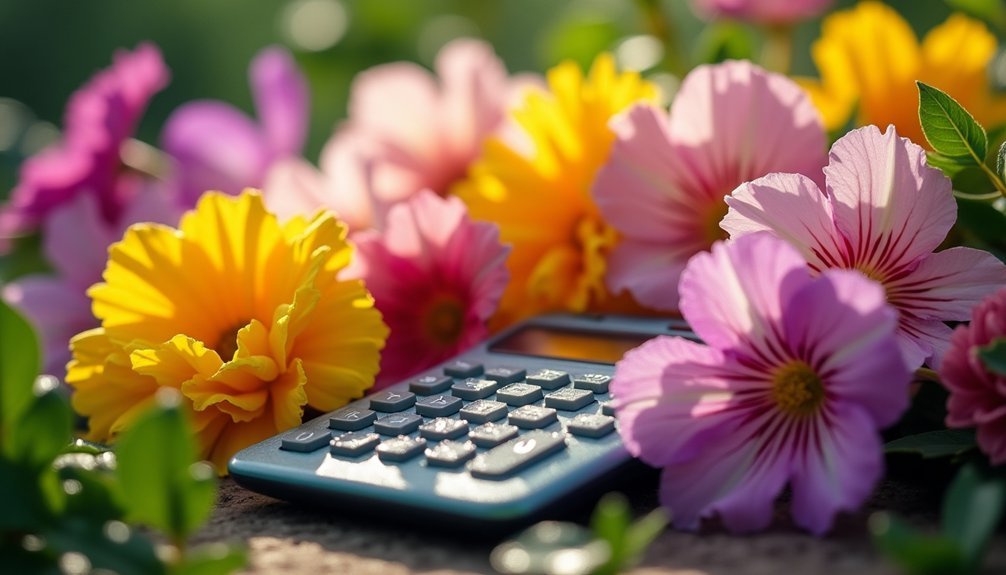



Leave a Reply